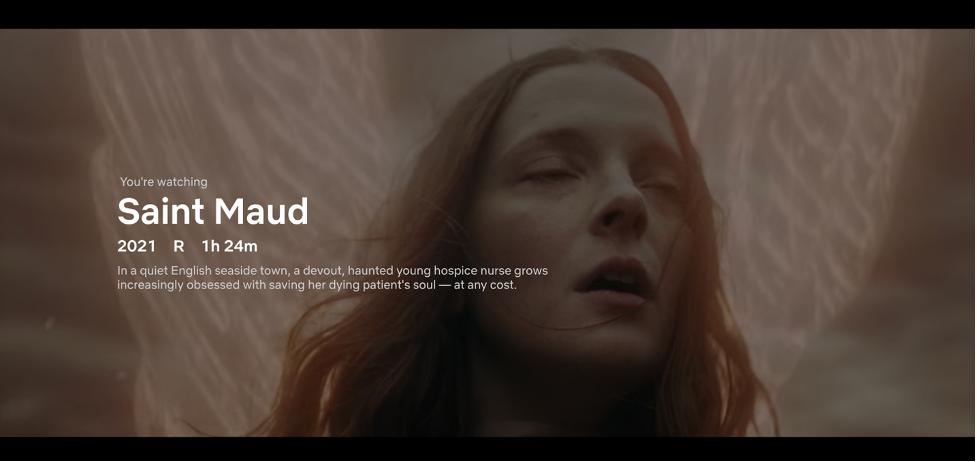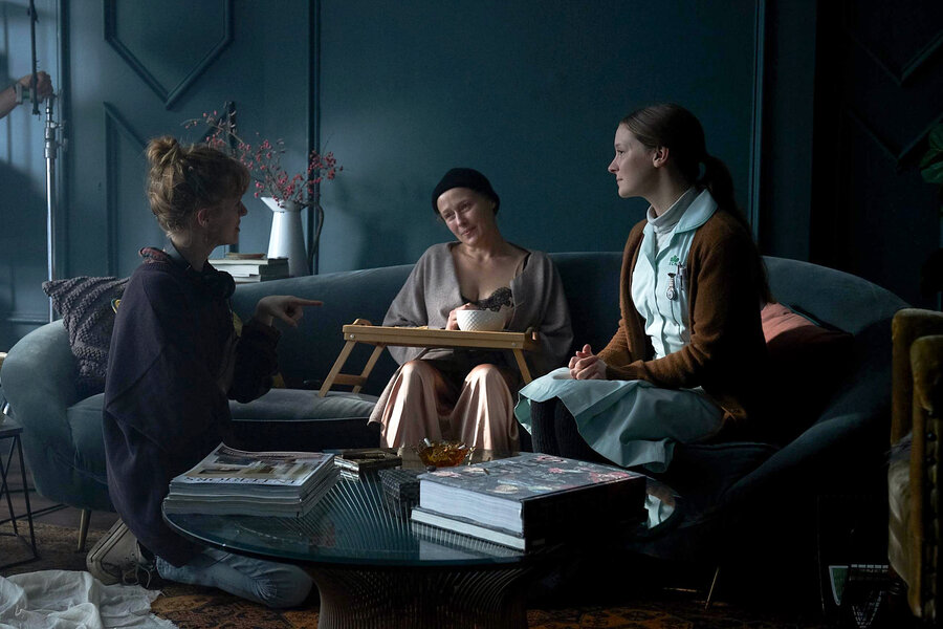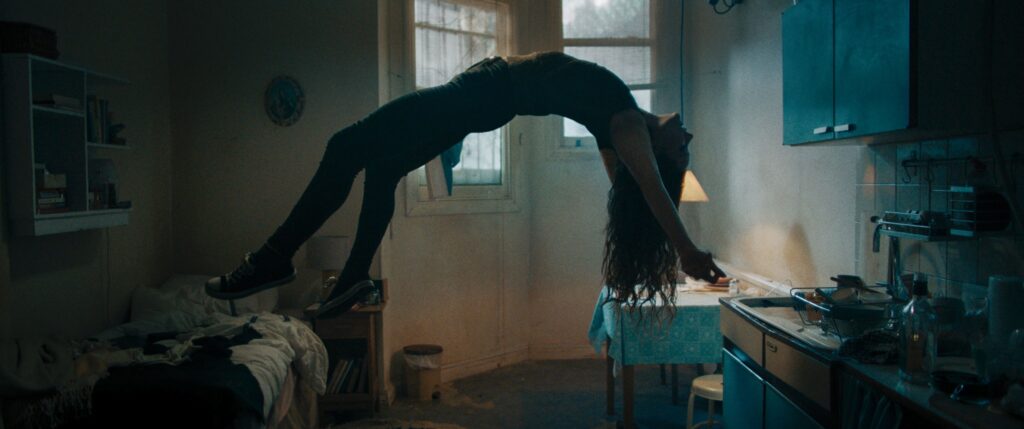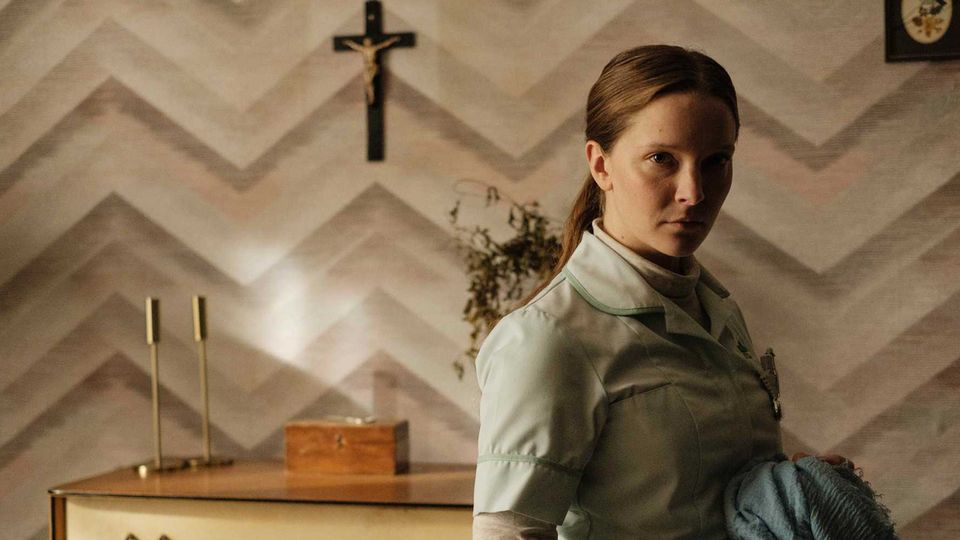Saint Maud and the Terror of God’s Presence
A review of the horror film Saint Maud and the movie's ideas about religion, gender, and mental health

(An image from the film Saint Maud)
“Presence is real, but not necessarily good, not necessarily bad, and it is rarely either good or bad…It is a dreadful thing to be in relationship with the gods really present. Painful and unexpected consequences may ensue. It is not safe to be so raw and vulnerable to real presences, to make desire and need so transparent.” – Robert Orsi
*This review contains spoilers of the film Saint Maud.
***
When I was a child, my Catholic mother implored me not to watch scary movies because she believed they would invite demons and evil spirits into our living room. If I played the tape, I might become a girl possessed.
But as scared as I was, I couldn’t resist. I ravenously consumed all of the horror I could get my hands on. I secretly watched The Shining and The Exorcist at Halloween. I rented Amityville Horror, Carrie, and Poltergeist from Blockbuster with my aunt for our summer sleepovers. And when I was in middle school, I persuaded my friends to see The Texas Chainsaw Massacre remake in theaters instead of Elf.
I loved how real the supernatural elements of these movies felt, and how that feeling stuck with me afterward, while simultaneously empowering me to push back against my mother’s supplication with another version of reality, that these were just movies. Evil can’t befall those who watch horror flicks, right?
Such visceral responses to horror are not isolated to my own experience. At parties, friends and acquaintances, Catholic or not, have shared similar stories of parental chastisement and irrational fears of the paranormal breeching the normal.
Famously, the theatrical release of The Exorcist in 1973 prompted rumors about a curious onset of “severe physical reactions” from watching the movie, including vomiting, fainting, heart attacks, miscarriages, and seizures. Psychologists reported an uptick in patients who believed they were possessed. In more extreme cases, some viewers attempted suicide and murder.
Or take The Ring, a 2001 American remake of a Japanese film based on a novel about a cursed videotape, where bad things happen to unsuspecting people because they dared to engage with haunted media.
What these pop culture and anecdotal examples suggest is that the potential for, and fear of, something transferring, or moving, between realms is both a horror trope and a religious feeling.
The possibility of otherworldly presence, whether good or evil, is gripping, frightening even. It’s what makes religious horror sell to the masses and convinces young Catholics to fall in line. Horror’s intimacy with the tension between reality and fiction, and the viewer’s willingness to suspend her disbelief for the sake of a good scare, remain the source of my fascination with the genre to this day.
So, as all good horror movies should, Saint Maud (2021) plays with our sense of what is real by tapping into the perspective of its main character. It offers viewers the possibility that divine, rather than demonic, presence can be the source of a film’s terror: What happens when God is part of the reason why bad things happen to unsuspecting people?
This is the question that Saint Maud elicits, building on a history of Catholic supernatural and psychological horror. Forgoing the classic formula of a slasher or demon-possession film, Saint Maud challenges viewers to imagine a twenty-first-century world where a person can speak to God and where God speaks back. In a fleeting 84-minutes, it shows us that for some people, God is real. And that realness can lead to some pretty horrific places.
***
Saint Maud is the debut film from British writer-director Rose Glass. Through its exceptional curation of sound, visual effects, and religious imagery, the film explores the line between what is real and what is not, as told through the everyday experiences of a young hospice nurse named Maud (Morfydd Clark). Inspired by Roman Polanski’s 1965 arthouse horror film Repulsion and her own Catholic upbringing, Glass uses personal religious piety—from prayer to self-mortification—to build a narrative about Maud’s internal world and how it shapes her relationship with those around her.
In the opening scene, a pot of tomato soup bubbles while a couple fights in Maud’s neighboring apartment. Maud, a quiet woman in her mid-twenties and austere in both dress and demeanor, is in the middle of packing her things. A clock ticks loudly. To drown out the noise, Maud begins speaking to God. She asks him to watch over her and tells him the exact time she’ll have to wake in the morning to get ready for work. With a fluid voiceover and scene change, her prayer continues into the next day. She lists the supplements she had taken, what she ate for breakfast, how she feels, and even goes so far as to beg for a revelation, admitting to her growing impatience for divine intervention in the humdrum of her banal life. “I can’t shake the feeling that you must have saved me for something greater than this. Not that I’m complaining. Amen.”
After Maud moves into the guestroom of her new patient’s home, viewers are thrust into the minutiae of her job, including her patient’s ailing body, medical schedule, social life, career, and home. We watch and listen to every detail as if we are the god to whom Maud speaks.
The film’s voyeuristic intimacy builds as the audience encounters each character.
Maud’s new patient, Amanda Köhl (Jennifer Ehle), is a forty-nine-year-old American dancer succumbing to lymphoma in her British seaside home. She is elegant, adorning herself with wigs and luxurious robes, and forthright in character. She knows what she wants and is not afraid to ask for it, even if it means putting Maud on the spot. As we learn from Amanda’s last words to her hospice nurse, their tumultuous relationship was a distraction from death. “I’m so sorry I was unkind to you,” she said. “You made me think of things I didn’t want to.”
Amanda’s art is her life’s accomplishment, felt in the music that fills her home and the recordings of past performances that play on her television set. Based on the guests she entertains, the drinks she slugs, and her chain-smoking, it seems Amanda is not ready to let go of who she was. Her body is a source of pleasure not only because of what it can do as a dancer, but also as a lover, which the film explores through the character of Carol (Lily Frazer), a young sex worker and companion Amanda hired. Carol and Maud are lifelines in Amanda’s attempt to maintain some semblance of her life in her last days, vulnerable and utterly dependent on those who care for her physical and sexual needs.

(A scene from Saint Maud)
Most of the film takes place in Amanda’s home, which sits on a hill overlooking the sea. The interior is rich with dark wooden panels and ornate wallpapers. The windows are either stained or speckled glass and take various geometric shapes, echoing the architectural structures of a cathedral. Each room has a personality of its own. As the film progresses, the house becomes a stage for Maud’s divine and interpersonal drama. Without a church of her own, the kitchen and bedroom are where she privately burns, scratches, and picks at her skin, acts of self-harm that come after revelations, either to thank God or to punish herself for doing something wrong.
Take the following scene: After a late-night conversation with Amanda, Maud walks back to her room, breathing heavily. She struggles to make it up the stairs. A horn begins to sound. Clinging to the wall and smiling, Maud falls on her back, groping herself and the carpet. Electricity crackles and lights flicker overhead as she experiences her first ‘godgasm,’ an ecstatic release made all the more vivid as low hums and faint whispers surround her contorted body. It’s Maud’s reward from God for breaking through to Amanda.
Clark’s performance of the godgasm looks exactly how it sounds: joyful, pleasurable, sexual, yet agonizing. It’s an orgasm from God, not unlike the ecstasy medieval mystics experienced or that Renaissance artists depicted in their sculptures.
In an interview, Glass explained that the concept of a godgasm emerged as a way to express how Maud and God communicate without distracting the viewer with too much dialogue. She wanted their relationship to be relatable by showing how God “makes her feel really good,” in the same way drugs might.
Given the various Christian taboos that surround female sexuality, it’s no surprise that sex plays a frequent role in Catholic horror. But Glass’s concern with women whose bodies serve as witnesses to otherworldly presence is not limited to cinema and its sex obsession. It’s also the content that drives academic and theological podcasts and fuels ongoing debates on the extent to which religious experiences overlap with psychiatric disorders.

(A scene from Saint Maud)
Too often, horror films dismiss women’s experiences of unusual or supernatural events as figments of their imagination. Rosemary’s Baby and False Positive are but a few telling examples of how “hysteria” is handled at the narrative level. What Saint Maud does differently, though, is it invites us to straddle the dangers and ecstasies of religion when taken into a woman’s own hands, without judgment (at least until the film’s final act).
With a female writer-director behind the camera, and women in the leading and supporting roles, Saint Maud lends itself to a more complex representation of women in horror, a genre that has broadly been characterized by an overwhelmingly male gaze. The film takes women seriously and, in turn, takes God seriously, all without foreclosing the possibility that Maud’s encounters with God are actually a form of psychosis.
This is best portrayed through God himself, a character in the film who takes many forms: a wooden crucifix, a voice, and a feverish whirlwind. He even appears to Maud as a cockroach, speaking in Welsh from her bedroom wall, commanding her to perform a final test so they can “be together truly.” All versions of him are recognizable to Maud, but visually inconsistent to the viewer. These inconsistencies distance us from Maud’s dominating perspective, leading to other moments in the film where we question what we know as true. When she bumps into Joy (Lily Knight), an old colleague, we learn that Maud’s name is actually Katie. Later on, after Maud was fired by her employer, she calls Joy in a drunken stupor, asking her to come out for a drink. It seems that the conversation goes sour and that Joy refuses the invitation, but when she checks in on Maud toward the film’s end, it turns out that the two women had actually made plans to meet, but Joy never showed. “I tried to call, but you didn’t pick up,” Joy claims.
Once these bits of information are revealed, it’s hard not to go back to other instances in the story to figure out whose version of reality we’re actually experiencing. What really happened? How much of what we have seen is the true playing out of events?
There are moments in the film, though, where Maud’s reality becomes palpable to others, drawing attention to their plausibility and absurdity. One night, after getting drunk with a friend, Amanda asks Maud to stay by her bedside and begins to ask a series of questions: “How long have you been doing this? Have you seen a lot of death? What made you leave [your previous job]?”
Maud struggles with this last one, but her answer is God. “It’s what God wanted. When he came, everything changed.”
“So, this is a recent conversion?”
Maud nods.
“When you pray, do you get a response?”
“Sometimes he talks.”
“You hear his voice?” Amanda asks, with a slight smirk.
Maud nods, smiling. “Most of the time, it’s like he’s physically in me or around me. It’s how he guides me. Like when he’s pleased, it’s like a shiver or sometimes it’s like a pulsing. And it’s all, warm and good. And he’s just, there.”
Eventually, Amanda admits she is struggling with the uncertainties of death. “Nothing feels real anymore. I keep thinking about that last moment, and wondering what it will be like … will there be anyone else there … and then what … nothing? Tell me I’m wrong.”
This conversation is a turning point in their relationship.
In this moment of mutual vulnerability, Amanda names her hospice nurse her “saviour,” prompting Maud’s first godgasm, and with this external validation, God not only becomes more present in Maud’s life, but in Amanda’s too.
Maud now sees it as her responsibility to care for Amanda spiritually, to heal her by replacing her doubt with the firm conviction that God is real.

(A scene from Saint Maud)
A few days later, Amanda asks Maud to join her in the living room for breakfast. They sit side-by-side on the couch and as Maud begins to say grace quietly to herself, Amanda shuts off the television so Maud can pray openly. Maud smiles and accepts the invitation. But in this scene, Amanda’s reactions are quite different from the frankness she expressed when she spoke about death the previous night. She smiles, smirks, and scoffs at Maud. And yet, the two of them eventually feel God’s presence together. “He’s here. I feel it too,” Amanda says. The experience verges on orgasmic. Amanda looks to Maud, mirroring each gasp for air. She throws her head back in ecstasy and reaches for Maud’s hand.
Whether any of this was real to Amanda is questionable. Was she indulging Maud or genuinely experiencing God? You’ll have to watch the film to get your answer. Nevertheless, Maud’s desire for salvation becomes conflated with Amanda’s desire for connection, both attempting to escape her own loneliness. Each woman inhabits her version of reality while projecting her desires onto the other.
Although Saint Maud explores these multiple perspectives to tell its story, the film’s horror lies in the fact that, according to Maud, her relationship with God was always real. Glass observes that “we all live in the same world, but we’re all confined to our bodies and all experience reality subjectively. You never really know what’s going on in someone else’s head.” For this reason she finds it “lazy and quite dangerous … to dismiss people who do terrible things as just inherently bad or mad people.” Instead, Glass offers a nuanced look into the life of a woman so fiercely devoted to her soul-saving mission that it propels the film to its tragic end.
***
Depending on how you interpret it, Saint Maud can be a hagiography gone wrong, a profile of a hospice nurse intent on saving a soul, or a detailed account of a slow descent into psychosis. Nonetheless, it shows us that for some people God is real, a presence felt and experienced, a voice made audible, a presence that can feel really good, but can also cause people to do pretty horrific things (like self-inflicted harm and violence against others).
But Saint Maud may also be a commentary on how the Church has dealt with mental health historically. As Glass notes, there were times when if God spoke to you, like Joan of Arc, “you became a saint…but if you go around saying those things now, alarm bells start ringing.” It’s a line that the Vatican has treaded lightly, most notably in Pope Francis’ recent confession to seeing a psychotherapist. And, as Alyssa Maldonado-Estrada shows in her conversations with tattoo artists, the reality that “some Saints lived with mental illness” is not lost on laypeople and cultural Catholics — “‘a lot of the saint stuff is really dark … you’re like shit, they were not in a good way. It’s super fucked up.’”
It’s hard to watch Saint Maud and not see how Glass is tapping into this fuckedupness too, leaning on her own religious formation in a Catholic all-girls school and familiarity with the visual vocabularies of film, horror, art, and religion to establish the film’s Catholic mood.
Maud, after all, suffers a similar fate as St. Afra (who burned at the stake), the namesake of the hospital she worked at before going into private care. But unlike The Exorcist, there is no need for a priest to intercede and excise a demon on behalf of a helpless woman who wants her life to go back to normal. Maud is seemingly in control of her own end as a profoundly personal experience with God.
In the end, Maud was not a saint in the traditional sense (formally recognized by the Church), but she tried to live like one. Maud sought to redeem herself and others from sin by committing physical and spiritual acts that were intended to purify and save her soul. She communed with God and became his loyal servant. Through these acts, Glass shows us that interacting with God through a series of intense and recurring religious experiences is a real way of operating and existing in the world. Her caveat, however, is that it is not always safe to be so vulnerable.
Saint Maud, then, is not concerned with a medical explanation of what is going on with its anti-hero, nor with enlisting psychological interventions to help or dismiss her actions. Rather, Glass’s film presents us with the idea that presence, whether good or evil, real or imagined, is as transformational as it is horrific, and not just because our Catholic mothers told us so.
Christina Pasqua is a Ph.D. Candidate at the University of Toronto’s Department for the Study of Religion and in the Book History and Print Culture Program. She is currently a dissertation fellow with the Louisville Institute, writing about American visual culture and translation practices through Bible comic books.